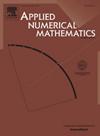Finite block method for nonlinear time-fractional partial integro-differential equations: Stability, convergence, and numerical analysis
IF 2.4
2区 数学
Q1 MATHEMATICS, APPLIED
引用次数: 0
Abstract
This paper investigates a nonlinear time-fractional partial integro-differential equation. For temporal discretization, the Caputo fractional derivative is approximated using the weighted and shifted Grünwald–Letnikov formula, while the Volterra integral operator is addressed using the fractional trapezoidal rule. Spatial discretization employs Chebyshev nodes as discretization points, and the spectral-collocation method is used to approximate the partial derivatives. To handle irregular computational domains in the two-dimensional nonlinear problem, the finite block method is adopted. The quasilinearization technique is implemented to manage the nonlinearity, transforming the problem into a linear form. Rigorous analysis of the stability and convergence of the proposed numerical schemes is conducted, and their effectiveness is demonstrated through numerical experiments, confirming both accuracy and efficiency.
非线性时间分数阶偏积分微分方程的有限块法:稳定性、收敛性和数值分析
研究一类非线性时分数阶偏积分微分方程。对于时间离散化,Caputo分数阶导数使用加权移位grnwald - letnikov公式逼近,而Volterra积分算子使用分数梯形规则求解。空间离散化采用切比雪夫节点作为离散点,采用谱配点法逼近偏导数。为了处理二维非线性问题中的不规则计算域,采用了有限块法。采用拟线性化技术处理非线性问题,将问题转化为线性形式。对所提数值格式的稳定性和收敛性进行了严格的分析,并通过数值实验验证了其有效性,验证了其准确性和有效性。
本文章由计算机程序翻译,如有差异,请以英文原文为准。
求助全文
约1分钟内获得全文
求助全文
来源期刊

Applied Numerical Mathematics
数学-应用数学
CiteScore
5.60
自引率
7.10%
发文量
225
审稿时长
7.2 months
期刊介绍:
The purpose of the journal is to provide a forum for the publication of high quality research and tutorial papers in computational mathematics. In addition to the traditional issues and problems in numerical analysis, the journal also publishes papers describing relevant applications in such fields as physics, fluid dynamics, engineering and other branches of applied science with a computational mathematics component. The journal strives to be flexible in the type of papers it publishes and their format. Equally desirable are:
(i) Full papers, which should be complete and relatively self-contained original contributions with an introduction that can be understood by the broad computational mathematics community. Both rigorous and heuristic styles are acceptable. Of particular interest are papers about new areas of research, in which other than strictly mathematical arguments may be important in establishing a basis for further developments.
(ii) Tutorial review papers, covering some of the important issues in Numerical Mathematics, Scientific Computing and their Applications. The journal will occasionally publish contributions which are larger than the usual format for regular papers.
(iii) Short notes, which present specific new results and techniques in a brief communication.
 求助内容:
求助内容: 应助结果提醒方式:
应助结果提醒方式:


